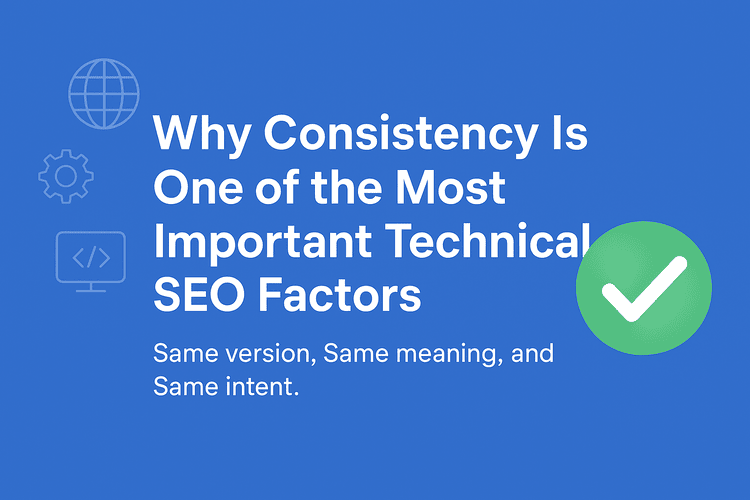As AI systems increasingly shape how people discover content — from Google’s SGE (Search Generative Experience) to ChatGPT’s Answers and Perplexity’s citations — one ranking principle remains absolutely critical: Consistency.
Google’s John Mueller has repeatedly emphasized that consistency is “one of the most important technical SEO factors.”
In the past, consistency helped search engines understand your website.
Today, it also helps AI systems interpret your signals, rewrite your content, and use it in AI answers.
That makes consistency a powerful ranking advantage in:
- Traditional SEO
- AEO (Answer Engine Optimization)
- SGE visibility
- AI-generated search results
- Knowledge Graph accuracy
This blog breaks down why consistency matters, how it impacts AI and SGE, and the exact steps you need to fix inconsistencies on your site.
What “Consistency” Means in Technical SEO Today
Consistency means that every signal across your website — URLs, internal links, canonicals, sitemaps, structured data, and metadata — all reinforce the same version, same meaning, and same intent.
In short:
Google and AI systems should see the same message everywhere.
There must be no contradictions in your technical signals.
When your site is inconsistent, Google and AI models lose trust.
When it’s consistent, they reward you with:
- Higher rankings
- Stronger inclusion in AI answers
- Clean indexing
- Faster crawling
- Clearer semantic understanding
Why Consistency Matters Even More Now (AI + SGE + AEO)
Search is no longer just “10 blue links.”
AI systems now read, summarize, and repurpose your content.
Where your content is judged today:
- Google SGE answers
- Google AI Overviews
- ChatGPT’s search layer
- Perplexity’s citation engine
- Bing Chat
- Gemini and other LLM-driven experiences
These systems depend on clean, consistent signals to determine:
- What your page is about
- Which URL is authoritative
- Which answers should be used
- Whether you deserve a citation
- Whether you should appear in SGE panels
When your website is inconsistent:
AI systems may pick the wrong URL
Your content may be omitted from AI answers
Google’s SGE may “hallucinate” outdated info
Ranking signals become split
Trust decreases
When your website is consistent:
AI and search systems confidently use your pages
You gain more SGE visibility and answer placements
You build strong topical authority
Google indexes your preferred URLs correctly
SEO performance becomes far more stable
Types of Consistency That Matter Most for AI, SEO, and SGE
1. URL & Domain Consistency
AI models hate mixed signals.
Avoid combinations like:
- http vs https
- www vs non-www
- trailing vs non-trailing slashes
- uppercase vs lowercase URLs
AI systems interpret these as different pages.
Best practice:
Pick one version and enforce it sitewide.
2. Canonical Consistency
Your canonical tags must align with:
- internal links
- sitemap URLs
- hreflang URLs
- actual page content
Contradictions confuse Google and break SGE visibility.
If canonicals conflict with internal links, AI systems may:
- consider your content duplicate
- choose the wrong URL
- ignore your pages in answers
3. Internal Linking Consistency
Internal links must always point to the canonical version.
AI answer engines rely heavily on internal linking structure to determine:
- topical authority
- semantic hierarchy
- primary pages
Inconsistent internal links dilute page strength.
4. Sitemap Consistency
Google and AI systems use sitemaps as “source of truth.”
Your sitemap must include:
- only canonical URLs
- only indexable URLs
- no redirects
- no 404s
- no robots-blocked pages
Inconsistency = lower trust.
5. Metadata & Content Consistency
Your:
- title
- H1
- opening paragraph
- schema markup
- meta description
…should all reinforce the same search intent.
This is not just SEO — AI systems use these as confidence signals.
6. Structured Data Consistency
If your structured data says one thing and your on-page content says another, AI systems may:
- ignore your schema
- misclassify your content
- exclude you from SGE
Consistency here boosts:
- rich results
- SGE inclusion
- AI summarization accuracy
- E-E-A-T perception
How Consistency Impacts AEO (Answer Engine Optimization)
In AEO, the key goal is to make your site the best possible source for AI to extract answers from.
Consistency helps answer engines:
- index the correct page
- understand your topical depth
- trust your structured data
- use your content in short-form answers
- validate you against competing sources
If you want citations in:
- SGE
- Perplexity
- Bing Chat
- ChatGPT Search
…consistency dramatically increases your chances.
How Consistency Helps You Appear in SGE
Consistent technical signals allow SGE to:
- understand your entity relationships
- verify facts
- connect your content to search intents
- pull accurate excerpts from your site
SGE tends to promote sites that:
- have strong internal linking
- have clear canonical structures
- match intent consistently across content
- use accurate schema
- maintain semantic clarity across pages
Consistency makes your content “SGE ready.”
Practical Checklist: Fix Consistency and Strengthen Your AI/SGE Visibility
URL-Level Consistency
One domain version
One URL format
No duplicates
No parameter chaos
Indexation Consistency
Robots.txt matches sitemaps
Canonicals match internal linking
No-indexed pages are excluded from sitemaps
Content Consistency
Title → H1 → First paragraph = same topic
Schema matches page purpose
Internal links reinforce main entities
Content stays aligned to search intent
AEO/SGE Consistency
Use concise, extractable answers
Avoid contradictory facts
Implement FAQ schema
Use clear semantic structure (H2/H3)
Final Thoughts: Consistency Is the Bridge Between SEO and AI Search
What John Mueller has been saying for years is now more relevant than ever:
If your signals are consistent, search engines trust you.
If search engines trust you, AI systems use your content.
If AI systems use your content, you win the future of search.
Consistency isn’t just a technical SEO factor anymore —
it’s a ranking multiplier across SEO, AEO, SGE, and AI-driven discovery.

